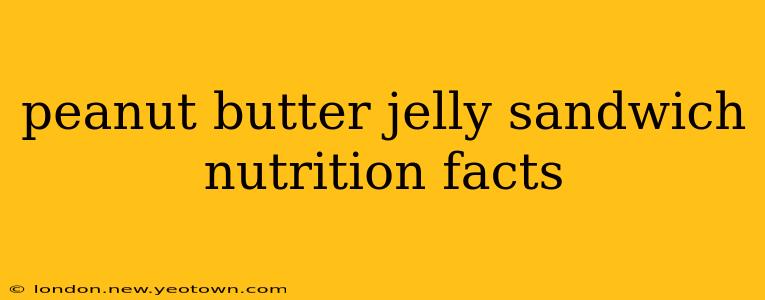The Surprisingly Nutritious Peanut Butter and Jelly Sandwich: A Deep Dive
The humble peanut butter and jelly sandwich. A childhood staple, a quick lunch, a comforting snack. But have you ever stopped to consider the nutritional powerhouse packed within those two slices of bread? It's more than just sugar and fat, folks! Let's unpack the nutritional facts, debunk some myths, and explore the variations that can boost its health profile.
This isn't just a quick rundown; we'll delve into the specifics, answering the questions many people have about this beloved sandwich. Consider this your ultimate guide to understanding the peanut butter and jelly sandwich's nutritional value.
What are the nutritional benefits of a peanut butter and jelly sandwich?
This is where things get interesting. A classic PB&J isn't a health food champion, but it offers a surprisingly balanced nutritional profile, depending on the ingredients. Let's break down the key players:
-
Peanut Butter: A good source of protein and healthy fats (mostly monounsaturated and polyunsaturated). These fats are beneficial for heart health and provide sustained energy. It also contains fiber, contributing to digestive health. Be mindful of added sugars and sodium levels – opt for varieties with minimal added ingredients.
-
Jelly/Jam: Primarily provides carbohydrates for quick energy. However, this is where the sugar content can become a concern. Many jams and jellies are loaded with added sugars. Look for low-sugar or no-sugar-added options to minimize the impact on your blood sugar levels.
-
Bread: Contributes carbohydrates, and depending on the type of bread, fiber and various vitamins and minerals. Whole-wheat bread is a far healthier choice than white bread, offering more fiber and nutrients.
The overall nutritional value depends heavily on the specific ingredients chosen. A sandwich made with whole-wheat bread, natural peanut butter (with minimal added ingredients), and low-sugar jelly will have a significantly better nutritional profile than one made with white bread, sugary jelly, and peanut butter loaded with added sugar and salt.
How many calories are in a peanut butter and jelly sandwich?
The calorie count can vary wildly, ranging from approximately 250 to 450 calories depending on the size of the sandwich, type of bread, and the amount of peanut butter and jelly used. A larger sandwich with white bread, generous amounts of peanut butter and high-sugar jelly will naturally be higher in calories.
What are the macro and micronutrients in a peanut butter and jelly sandwich?
The macro and micronutrient content also fluctuates based on the ingredients. However, a generally well-made PB&J will provide:
- Carbohydrates: Primarily from the bread and jelly.
- Protein: Primarily from the peanut butter.
- Fats: Mostly healthy fats from the peanut butter.
- Fiber: Primarily from the bread (especially whole-wheat) and peanut butter.
- Vitamins and Minerals: A variety, depending on the bread and the type of jelly used. Some jellies might be fortified with vitamins.
Precise amounts will require calculating based on the specific nutritional information of your chosen ingredients.
Is a peanut butter and jelly sandwich healthy?
The healthiness of a peanut butter and jelly sandwich is entirely dependent on the ingredients you choose. A sandwich made with nutrient-rich ingredients can be a balanced and satisfying meal. However, a sandwich made with highly processed ingredients will lack the nutritional value and may contribute to weight gain and other health concerns due to excessive sugar and unhealthy fats.
How can I make a healthier peanut butter and jelly sandwich?
Making a healthier PB&J is easy! Simply swap out the processed ingredients for healthier options:
- Choose whole-wheat bread: Provides more fiber and nutrients.
- Opt for natural peanut butter: Minimizes added sugars and sodium.
- Select low-sugar or no-sugar-added jelly or jam: Significantly reduces sugar intake.
- Consider adding fruits or vegetables: Sliced bananas, berries, or even a few spinach leaves can add extra nutrients and flavor.
By making these simple substitutions, you can transform your PB&J from a simple snack into a reasonably nutritious and satisfying meal.
This journey into the nutritional world of the peanut butter and jelly sandwich reveals that it's far more complex than it might initially seem. With thoughtful ingredient selection, it can be a surprisingly healthy and enjoyable part of a balanced diet. So next time you reach for a PB&J, remember the power of choosing wisely!

